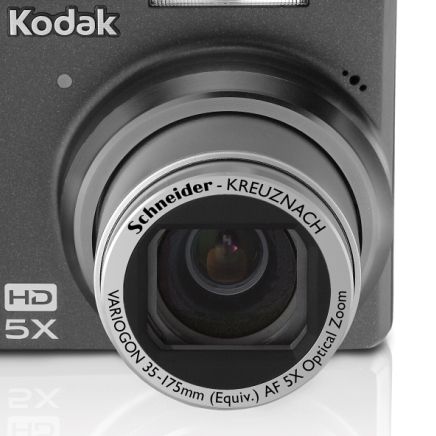Kodak’s EasyShare Z1085 IS crams in 10 megapixels and offers 5x optical zoom in a package small enough to slip into your pocket. But is this the smart snapper to go for? We shoot a few frames to find out.
Our quick take
The 10 megapixels don’t necessarily deliver a better photograph and the likelihood is that images taken will be used for standard display or online sharing, rather than producing full sized prints, which begs the question of why you’d want to go this high?
Overall we can’t help feeling a bit disappointed with the package delivered. It feels as though the numbers have been increased to offer people 10 megapixels and HD video but without rounding off the package. Yes, price needs to be considered, but with so many options on the market, this just isn’t a model we’d want to go for.
The lack of a chargeable power pack or even a memory card in the box is disappointing, so consider this when comparing prices.

Kodak EasyShare Z1085 IS digital camera - 3.0 / 5
| FOR | AGAINST |
|---|---|
|
|
The Z1085 follows the familiar design of the Z series of Kodak cameras, typified by the right-hand bulge that serves to house two AA batteries, or rechargeable battery pack equivalent, as well as providing a decent grip to keep the camera steady.
Those on the road might appreciate the option of AA batteries but it does mean that you’ll have to invest in accessories if you want a rechargeable option. The right-hand bulge also houses the SD card - which is not provided in the box – and housed under a flap that sadly rattles when touched.
You’ll need that aforementioned grip specifically for two reasons: firstly, there is no viewfinder so this is an arms-length operation; secondly, the camera features a 5x optical zoom (35-175mm equivalent), at the far end of which you’ll need a steady hand to avoid shake. The "IS" moniker lets us know that optical image stabilisation is present and you can hear it whirring away as you line up those shots.
The body of the camera is black plastic and despite measurements of 89 x 63 x 39mm, it only has a 2.5in (64mm) LCD on the back. There seems to be a fair amount of space around the buttons mounted on the back, and with no viewfinder, there is certainly space for a larger screen - something that you’d potentially find on competitor models.
The top of the camera sports a control dial which allows you to switch modes: the normal full-auto, video, scene preset, program and manual options. Interestingly Kodak have chosen to include panoramic and a high ISO option on the dial. The high ISO option is becoming increasingly common and this automates the process, which, whilst this isn’t an ideal solution to shooting in low light conditions, does mean that the camera picks an ISO level appropriate to the shot, and avoids to a certain extent heading up to the higher ISO options and resultant noise.
ISO will head up to 3200 in normal options, but will go all the way up to 8000, although to reach those heady heights, you have to turn the image sensor down to 2.2MP. In reality, you probably won’t be looking at these far extremes for everyday point and shoot photography. The manual option is interesting because of the simplicity of the approach, you can alter all the options on the screen so if you have a fair idea of an effect you want, you should be able to achieve it.
Start-up times are slightly on the slow side, mainly due to the winding out of the lens and the same can be said of turning off. Also, there is no option to view images without turning the camera on proper, so that lens has to pop itself out even when leafing through shots. Another minor criticism was that the default display contains little information; it is only after two button presses that you can view more detailed image data, and you can’t opt to have this as your standard setting.
Shooting in full-auto with the Z1085 introduces Smart Capture in which the camera detects the best settings for you. Under normal shooting conditions it will correctly identify a landscape shot, or a macro scene and the display lets you know that this has been selected. Indoors however it is less accurate, for example, portraits becoming macro. You could use the preset scene modes to overcome this.
The presets also change the megapixels used by the sensor so therefore the aspect ratios alter. This is a consideration for those ordering images or printing at home, as you’ll have to ensure you select the correct option to avoid white stripes appearing on your lovely pictures. Whilst the system seems fairly convenient, we were left feeling a little under whelmed at the results, with colours a little flat. We also had focusing issues in the macro setting and at the far end of the zoom.
The camera also features Perfect Touch processing and we couldn’t find an option to switch this off, so before you can get to the images a degree of processing is already taking place, potentially stripping out detail.
One of the big boasts of Z1085 is that video can be shot in high-definition (1280 x 720) and the camera has HD branding on the front to remind everyone of this. If you are more interested in sharing over the web you can turn this option down to more manageable VGA or QVGA. All video is captured at 30fps, but you need to be careful with the zoom as focusing can lag behind the action.
To recap
Overall we can’t help feeling a bit disappointed. It feels as though the numbers have been geared up to 10 megapixels and HD video but without rounding off the whole package
